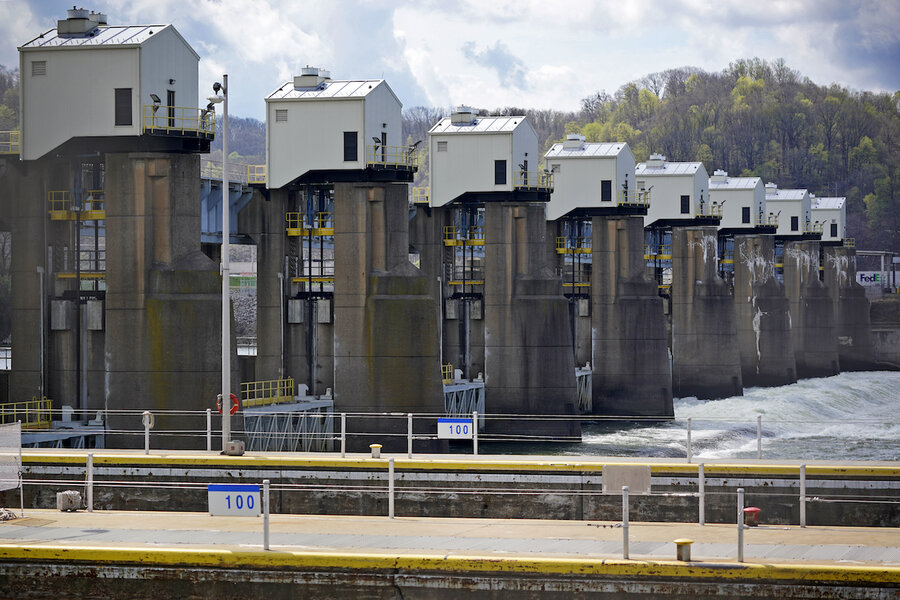Is hydropower the future of green energy? Why some say yes.
Loading...
| Washington
In southwestern Pennsylvania, eight locks and dams that for decades helped barges move goods along the Allegheny, Monongahela, and Ohio rivers will in a few years also generate enough power for 75,000 homes.
Rye Development, a Boston-based hydropower company, is retrofitting the dams with turbines to generate electricity and says the upgraded structures will limit damage to the rivers’ water quality and fish.
The project reflects a recent thawing between the industry and conservation groups, which had long opposed dams that can prevent fish migration, alter water temperatures and cause other environmental problems. As the United States pushes to transition to low-carbon energy, Rye is among the companies that sees an opportunity to expand hydropower production at existing dams while working to minimize environmental harms.
The recent compromises between the industry and environmental groups are reflected in President Joe Biden’s infrastructure law, which puts $2.5 billion toward projects including dam removals as well as upgrades at existing structures for hydropower and energy storage.
“We do recognize that [hydropower] is probably going to play some role in the transition. It’s certainly better than coal,” said Ted Illston of American Rivers, which has advocated for dam removals on environmental grounds.
Hydropower, which uses flowing water to spin turbines connected to generators, is the oldest and second-largest renewable energy source in the U.S. after wind power. In 2020, it accounted for roughly 7% of the electricity generated in the country.
The industry hasn’t received as much federal funding and tax incentives as wind and solar but sees room for growth. Of the 90,000 dams in the country, about 2,500 produce power. Non-powered dams could produce enough power for 9 to 12 million homes, according to an estimate by the Electric Power Supply Association based on federal data from 2012.
Part of the challenge is that most dams in the U.S. were built more than half a century ago. The risk of dam collapses has fueled demolitions in recent years, with more than 40% of the country’s nearly 2,000 dam removals in the past century happening in the last decade. Some are also torn down largely for environmental reasons.
Last month, federal regulators moved a step closer to approving what would be the largest dam demolition in U.S. history. Removal of the four hydroelectric dams on the Klamath River near the Oregon-California border would help save the river’s salmon and other fish species that can’t reach breeding habitat because of the structures.
The hydropower industry and conservation groups still clash over dams, too. On Maine’s Kennebec River, conservation groups and state environmental agencies are pushing for the removal of four hydropower dams that block endangered Atlantic salmon from reaching key habitat. The dams generate about 5% of the state’s renewable energy.
“It’s very easy for individual river systems to get lost in the message of climate change and the need for renewable energy,” said Shannon Ames, executive director of the Low Impact Hydropower Institute, which grades hydropower dams based on environmental criteria.
With persisting drought affecting hydropower production west of the Mississippi River, the industry has a more direct path to expansion in eastern states.
In Pennsylvania, Rye consulted with the Low Impact Hydropower Institute early in its process and is among a small number of companies seeking certification from the group.
To get certified, companies must show their structures meet protections for endangered species, cultural and historic uses of rivers, passage for fish, and recreational areas. The group says its environmental standards are often stricter than state or federal guidelines.
On a recently certified dam in West Virginia on the Ohio River, for example, dissolved oxygen levels – an important measure of river water quality – were meeting or exceeding state standards, according to a five-year study. In some states, dams certified by the organization qualify for green-energy programs.
Rye said its dams in Pennsylvania will include structures to support fish migration, and that it is building a fishing pier since federal regulators require hydropower producers to support recreation on river systems. The retrofits are expected to be operational as early as 2025.
This story was reported by The Associated Press. The Associated Press receives support from the Walton Family Foundation for coverage of water and environmental policy. The AP is solely responsible for all content.





